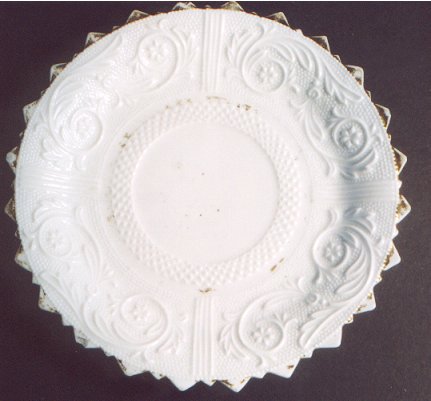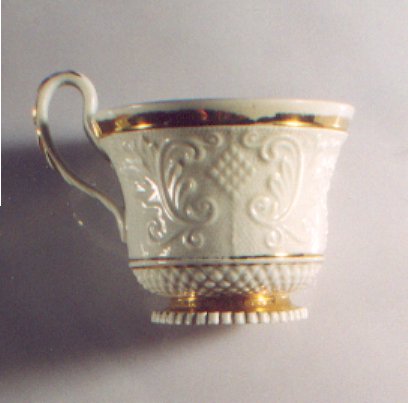|
Porcelain and Pressed Glass


The two pieces of porcelain shown above were made in Meißen in the first half of the 19th
century. In a paper first published in 1984 (see below), Dr. Joachim Kunze proved that between 1831 and 1855 the Meißen porcelain manufacture produced hundreds of different pieces of
porcelain which were either copied from or inspired by contemporary glassware.
Together with other cheap white porcelain, mostly richly gilded, these pieces were a big seller
worldwide for twenty five years. In some years they made up almost half of the turnover.
The manufacture bought quite purposefully glass from glassmakers in France, Bohemia and the U.
S. (and probably in Belgium and the Netherlands as well). They made copies and formed their own moulds. Cups, vases and other hollow glassware could be copied unchanged, whereas on flat
objects – with the pattern on the underside, visible through the glass – the pattern had to be applied on the surface and, in the case of saucers, a space in the centre had to be left free for the cup.
Production was discontinued in 1855, the moulds were destroyed and the rest was sold from
stock in the following years. The manufacture could again concentrate on producing luxury porcelain.
Art critics in the twentieth century treated this Meißen period as scornfully as Pazaurek (in his Gläser der Empire- und Biedermeierzeit) had treated French pressed glass, and as late as in the
1960's the manufacture itself was pretty reluctant to admit its fatherhood, as Mrs. Spillman reports in her introduction to Dr. Kunze's article.
Most of the information is taken from Dr. Joachim Kunze, "Meißner Porzellan nach Kristallmustern
(1831 – 1855)", in Keramos, No. 105, July 1984. Also in: Glass Club Bulletin 153 and 154,
Fall/Winter 1987, of the National American Glass Club. Excerpts from the article and other texts by Franke, Mundt and Spillman on this phenomenon in: Pressglas-Korrespondenz 2000/2, pp. 29-45.

|